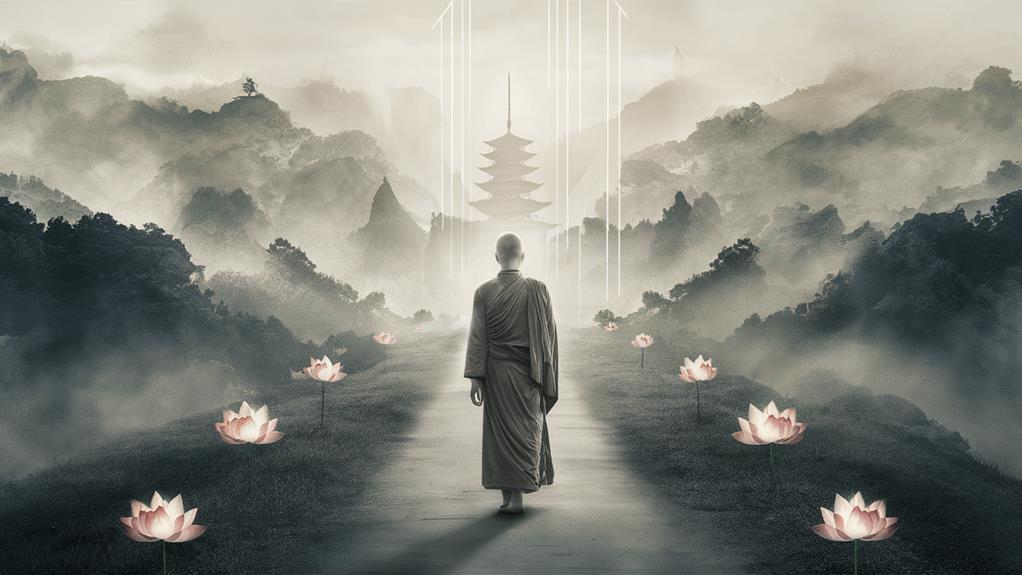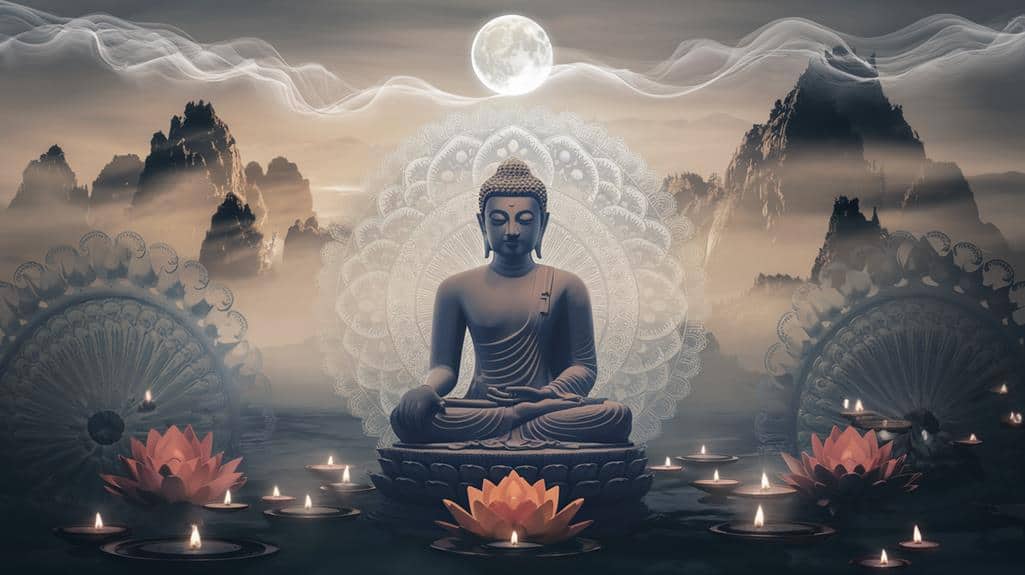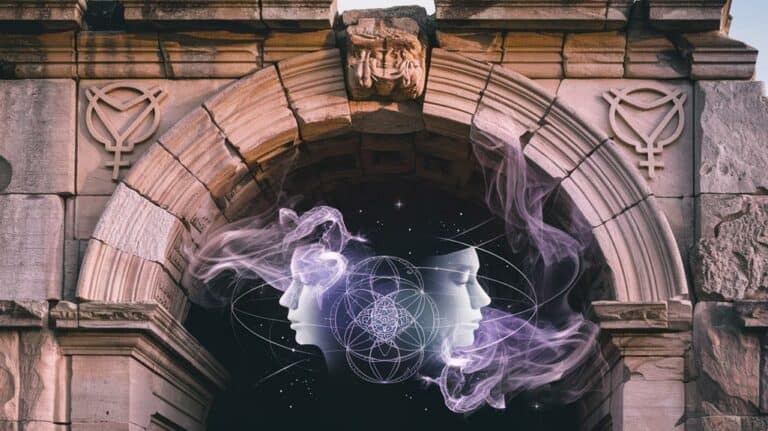What Is Buddhist Mysticism?
As you explore Buddhist mysticism, you’ll find it’s a spiritual practice that invites you to experience ultimate reality directly. You’ll use meditation and mindfulness to explore the nature of existence and your place within it. By letting go of attachments and embracing emptiness, you’ll begin to transcend the ego, revealing new insights into suffering and liberation. This journey isn’t about achieving some distant, abstract truth – it’s about understanding the world and yourself right now. As you start this path, you’re left with a pivotal question: what will you discover when the boundaries of your ego begin to fade?
Key Principles of Buddhist Mysticism

You’re encouraged to cultivate a deep awareness of the Four Noble Truths, which reveal the existence of suffering, its causes, its cessation, and the path to its end.
These truths aren’t merely theoretical concepts but practical truths that you can verify through your own experience. The principle of non-attachment is essential, as it allows you to see beyond the transient nature of all phenomena, including your own ego and desires.
Through practices such as mindfulness and meditation, you’ll develop a greater understanding of the interconnectedness of all beings and the impermanence of everything. This understanding is the foundation upon which Buddhist mysticism is built, offering you a path towards true freedom.
The Eightfold Path provides a framework for ethical living, mental development, and wisdom, guiding you to live a life that’s both compassionate and enlightened.
The Role of Meditation
Meditation plays a central role in Buddhist mysticism, serving as a practical tool to realize the theoretical truths discussed in the Four Noble Truths and the Eightfold Path. As you explore deeper into meditation, you discover its capacity to transform your understanding of reality and your place within it.
It’s through meditation that you develop mindfulness and concentration, essential components in uncovering the nature of the mind and reality.
Your practice begins with cultivating tranquillity (samatha) to calm the mind, making it receptive to deeper insights. Then, through insight meditation (vipassana), you gain a profound understanding of impermanence, suffering, and non-self, leading to a more compassionate and liberated existence.
Additionally, meditations such as loving-kindness (metta) help you foster empathy and kindness towards all beings, including yourself, breaking down barriers and fostering interconnectedness.
Exploring Subjective Experience

Diving deeper into the mystical aspects of Buddhist practice, the exploration of subjective experience becomes pivotal. You find yourself delving into the heart of what it means to truly perceive reality unfiltered by conceptualizations and interpretations.
In this domain, the distinction between the self and the external world blurs, allowing for a direct communion with ultimate reality.
Mystical experiences in Buddhism are characterized by a profound sense of unity, wholeness, and connection, transcending the ordinary boundaries of the self. It’s as if the inherent interconnectedness of all phenomena becomes palpable, leaving a profound impact on your perception of existence.
As you explore the subjective nature of these experiences, you may question whether they reveal an objective reality or are merely personal insights. However, the depth and transformational power of these experiences suggest they touch upon something fundamental, challenging your understanding of the self and the world.
In this exploration, the path to enlightenment becomes a journey of self-discovery, pushing the boundaries of what’s possible to know and experience. You find yourself immersed in a profound dialogue between the subjective and the ultimate, a dialogue that reshapes the very fabric of your existence.
Nature of Reality and Enlightenment
The profound quest for enlightenment in Buddhist mysticism centers on revealing the true nature of reality. You’re invited to explore the intricate dance between existence and perception, where the fleeting nature of phenomena is laid bare.
Buddhist teachings emphasize the interconnectedness of all things, underscoring that nothing exists independently. This reality is characterized by impermanence (anicca), suffering (dukkha), and the absence of a permanent self (anatta).
As you navigate this philosophical terrain, you’ll encounter the concept of dependent origination (paticca-samuppada), which highlights the interplay between phenomena. This understanding leads to the realization of emptiness (śūnyatā), a central tenet in Buddhist philosophy that illuminates the illusory nature of permanent identity and substantial existence.
Enlightenment, or the attainment of nirvana, involves a direct, non-conceptual insight into the nature of reality. You’re not merely grasping intellectual truths but gaining profound understanding through contemplation and mindfulness.
This journey transcends theoretical comprehension, inviting you to penetrate the fabric of reality and liberate yourself from the cycle of suffering and rebirth. Through such insight, you can embody the wisdom of non-duality, connecting with all of existence in a profound and transformative way.
Practices for Inner Transformation

Within the domain of Buddhist mysticism, practices for inner transformation are deeply intertwined with the quest for understanding the true nature of reality. You commence on a journey of contemplation and meditation to peel away the layers of conditioning and delusion that obscure your perception of the world.
By settling into stillness, you begin to see through the mental constructs that cause suffering and find a path toward liberation. Your practice becomes a lifelong endeavor, with each moment offering an opportunity for growth and awakening.
You cultivate mindfulness and concentration, observing your thoughts and emotions without attachment, and thereby gaining insight into the impermanent and interconnected nature of all phenomena. Through the Eightfold Path, you align your actions with wisdom, ethics, and mental discipline, fostering a deeper sense of compassion and understanding for yourself and others.
In this transformative process, you aren’t just changing your mind; you’re awakening to the boundless, luminous reality that underlies all existence. By embracing this path, you open yourself to the infinite possibilities of the present moment, unfettered by the constraints of the past.
Distinguishing Buddhist Mysticism
Buddhist mysticism distinguishes itself through its unique blend of philosophical and practical elements, setting it apart from other mystical traditions. As you explore deeper into its core, you’ll find that it intertwines meditation, mindfulness, and introspection in a way that fosters profound inner transformation.
The path of Buddhist mysticism invites you to examine the inner workings of your own mind and consciousness, guiding you toward a direct, personal experience of the ultimate reality.
This journey, deeply rooted in the teachings of the Buddha, emphasizes the cultivation of wisdom, ethical behavior, and mental discipline. You’re encouraged to initiate an inward journey, seeking to transcend the limitations of the ego and the external world.
Through practices such as meditation and contemplation, you’ll uncover layers of your own consciousness, leading to a deeper understanding of the interconnectedness of all phenomena.
In this transformative process, you’ll find that Buddhist mysticism offers a distinct path toward spiritual awakening, one that balances intellectual inquiry with personal, experiential insight. Your journey becomes a quest for liberation, bridging the gap between theoretical knowledge and lived experience.
Path to Ultimate Truth**

Meditation serves as a cornerstone on the path to ultimate truth, fostering a direct encounter with the deepest layers of consciousness. Through meditation, you dissect the layers of misconception that cloud your perception of reality, gradually revealing the truth in its purest form.
The distinction between conventional and ultimate truth becomes clear, allowing you to see through the veil of ignorance that binds you to suffering and misunderstanding.
In Buddhist philosophy, conventional truth refers to the way things appear to us, while ultimate truth is the deeper, absolute reality beyond the surface level. Nāgārjuna, a key figure in Mahāyāna Buddhism, emphasized the importance of understanding both levels of truth to achieve liberation.
By integrating this understanding into your practice, you can transcend the limitations of conventional thinking, experiencing reality in its most profound sense. This journey isn’t about reaching a destination; it’s about continually deepening your understanding and aligning with the ultimate truth that underlies all existence.
Your path to ultimate truth involves questioning the inherent nature of reality and recognizing the emptiness that lies beneath all phenomena. This insight liberates you from the cycle of suffering, allowing you to embrace the true nature of existence.
Conclusion
As you explore Buddhist mysticism, you’re invited to traverse the depths of your existence, seeking to reveal the ultimate truth. Through meditation and mindfulness, you’ll cultivate a profound understanding of reality, transcending the ego to achieve liberation from suffering. Embracing concepts like non-attachment, emptiness, and interconnectedness, you’ll journey toward inner transformation and enlightenment. In this sacred pilgrimage, the path to truth unfolds before you, beckoning you to investigate, contemplate, and ultimately, to understand.









